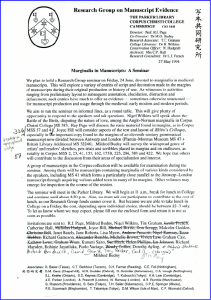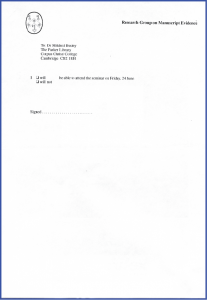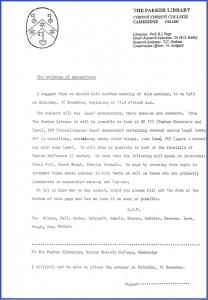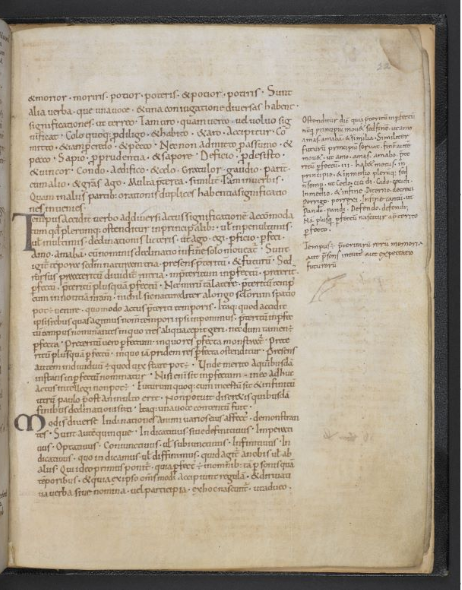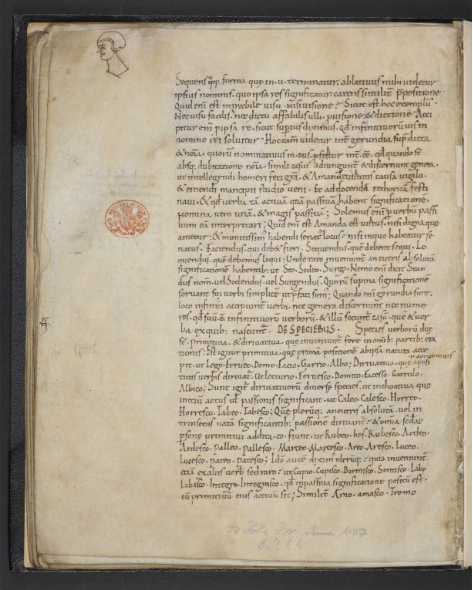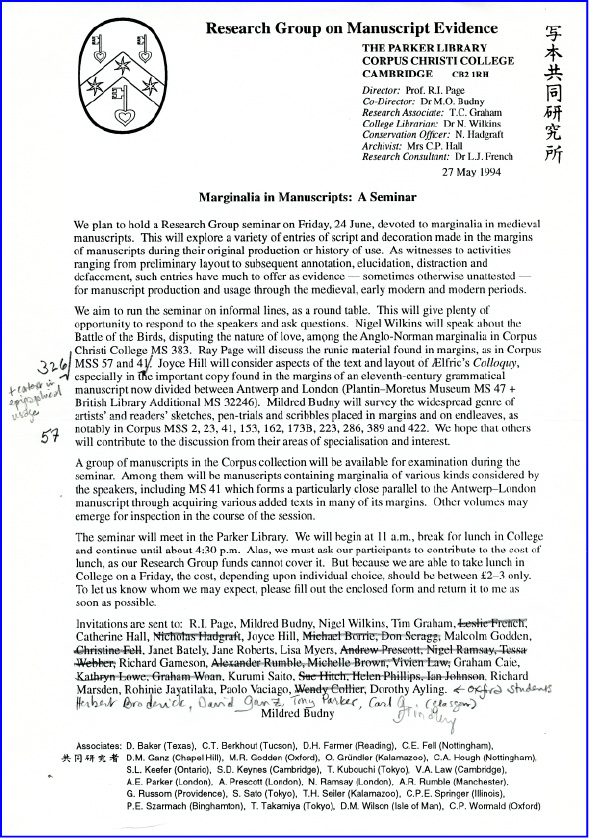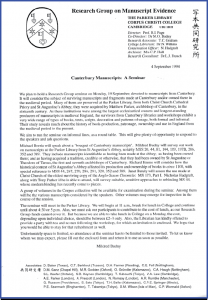Seminar on the Evidence of Manuscripts (June 1994)
September 12, 2016 in Manuscript Studies, Seminars on Manuscript Evidence
“Marginalia in Manuscripts”
Parker Library
24 June 1994
In the Series of Seminars on “The Evidence of Manuscripts”
The Parker Library, Corpus Christi College, Cambridge
Invitation in pdf, with 1-Page Invitation Letter and 1-page RSVP Form
The previous Seminar in the Series considered
“King Alfred and His Legacy”
(English Faculty Building, Oxford University, 20 April 1994)
[First published on 12 September 2016]
This seminar was “devoted to marginalia in medieval manuscripts.” A complicated and fascinating subject.
Now, at the distance of more than 20 years, Mildred Budny reviews the event, with some highlights, and considers its annotated Invitation Letter as a case in point.
The Plan
The 1-page Invitation Letter (both shown here and downloadable here with its RSVP Form) presents the plan. As customary for our web Reports or Posts about the Series, we transcribe the Letter here. And so to begin:
This will explore a variety of entries of script and decoration made in the margins of manuscripts during their original production or history of use. As witnesses to activities ranging from preliminary layout to subsequent annotation, elucidation, distraction and defacement, such entries have much to offer as evidence — sometimes otherwise unattested — for manuscript production and usage through the medieval, early modern and modern periods.
As usual, “we aim to run the seminar on informal lines, as a round table. This will give plenty of opportunity to respond to the speakers and ask questions”.
The Speakers and Subjects
The Invitation Letter lists the speakers and their proposed subjects in its word-processed lines of text. As circulated, that list is what was to be seen on the page. But there is more.
Plus (And It Is A Plus!) Marginalia
The annotated Master copy of the Letter in the Research Group Archives has handwritten notes in the margin to the left of this paragraph. The notes were made by the author of the letter, whose name it bears, in the course of organising the event, once the Letter had taken shape and entered into circulation.
We report those notes here, and signal them within square brackets [ ], plus a prefatory plus-sign (+). One of the annotations uses that sign, so the transcription uses its own sign, plus the prefatory indicator. One of these annotations — the uppermost — possesses the “response” or “answer” in a matching pair of omission-insertion signs (“asked” and “answered”), indicating the location within the text where the insertion is to be understood.
Such pairs of signs are a feature of long-standing proof-corrections and other forms of readers’, authors’, and editors’ entries which spot omissions, or augment, existing texts. After all, the author and sender of the Invitation Letter for the 24 June 1994 Seminar wrote a learned article about these features, so she should know. For reference, it concerns: “Assembly Marks in the Vivian Bible and Scribal, Editorial, and Organizational Marks in Medieval Books” (1995).
Although perhaps tempting, we can’t quite say that “She Wrote The Book On The Subject”. OK, it was an Essay. With some hand-picked (and early-printed) examples, no less. The ongoing interest in, and curiousity about, the processes of production and the stages of use which manuscripts undergo makes for repeated looking and wonderment. Amazing things happen to the pages of books, sometimes under our very own eyes.
On the annotated Master Copy, the last marginal entry for this paragraph, which adds the number of another Corpus manuscript to the list, simply stands there without any omission- or insertion-sign. Because the listed manuscripts in the main text follow numerical order — some other Invitation Letters in the Series do not cite them in that order — we are entitled, in our transcription now, to insert the supplied number within that sequence, rather than, say, at the end of the list. (Numerical order of the pressmarks, not chronological order of When-We-Thought-Of-Another-One.)
These things may seem obvious, especially if (or when, or if only) they are described clearly. But these observations, or principles of analysis and interpretation, pertain to the methods of decipherment of some forms of marginalia in many manuscripts across generations and centuries.
Here, we have an advantage in that that exposition comes from the very author of the text, the scribe of the marginalia (and the omission sign within the line), and the composer of this very Report. Would that, for many challenging pages with marginalia in manuscripts of many kinds and dates, there were more opportunities to question the source itself/himself/herself/themselves, that is, in a manner and shared time-span that allows for an authoritative answer? (Séances being Another Subject Altogether.)
The Cast
As presented in the Letter, and as augmented by its authorial Marginalia:
Nigel Wilkins will speak about the Battle of the Birds, disputing the nature of love, among the Anglo-Norman marginalia in Corpus Christi College 383.
Ray Page will discuss the runic material found in margins, as in Corpus MSS 57 and 41 [+ 326] [+ “+context in epigraphical usage”].
Joyce Hill will consider aspects of the text and layout in Ælfric’s Colloquy, especially in the important copy found in the margins of an eleventh-century grammatical manuscript now divided between Antwerp and London (Plantin–Moretus Museum MS 47 + British Library Additional MS 32246).
Mildred Budny will survey the widespread genre of artists’ and readers’ sketches, pen-trials and scribbles placed in margins and on endleaves, as notably in Corpus MSS 2, 23, 41, [+ 57 ,] 153, 162, 173B, 223, 286, 389 and 422.
As always, “we hope that others will contribute to the discussion from their areas of specialisation and interest”.
The Manuscripts
As above, namely:
A group of manuscripts in the Corpus collection will be available for examination during the seminar. Among them will be manuscripts containing marginalia of various kinds considered by the speakers, including MS 41 which forms a particularly close parallel to the Antwerp–London manuscript through acquiring various added texts in many of its margins.
As usual:
Other volumes may emerge for inspection in the course of the session.
The Logistics
More-or-less as usual for the Home Team.
The seminar will meet in the Parker Library. We will begin at 11 a.m., break for lunch in College and continue until about 4:30 p.m. Alas, we must ask our participants to contribute to the cost of lunch, as our Research Group funds cannot cover it. But because we are able to take lunch in College on a Friday, the cost, depending upon individual choice, should be between £2–3 only. To let us know whom we may expect, please fill out the enclosed form and return it to me as soon as possible.
The Participants
Invitations were sent to (including the names added as annotations to the Master Copy):
R.I. Page, Mildred Budny, Nigel Wilkins, Tim Graham, Leslie French, Catherine Hall, Nicholas Hadgraft, Joyce Hill, Michael Borrie, Don Scragg, Malcolm Godden, Christine Fell, Janet Bately, Jane Roberts, Lisa Myers, Andrew Prescott, Nigel Ramsay, Tessa Webber, Richard Gameson, Alexander Rumble, Michelle Brown, Vivien Law, Graha Caie, Kathryn Lowe, Graham Woan, Kurumi Saito, Sue Hitch, Helen Phillips, Ian Johnson, Richard Marsden, Rohinie Jayatilaka, Paola Vaciago, Wendy Collier, Dorothy Ayling, Herbert Broderick, David Ganz, Tony Parker, Carl Grindley.
Present (according to the returned RSVP forms in the Research Group Archives and the annotations to the list in the final paragraph on the Master Letter, which comprise entries both inline and around its lines of text, in the forms of more-or-less horizontal lines of cancellation and supplied names, plus a couple of remarks in parentheses or not about the locations of some students):
R.I. Page, Mildred Budny, Nigel Wilkins, Tim Graham, Leslie French, Catherine Hall, Joyce Hill, Malcolm Godden, Janet Bately, Jane Roberts, Lisa Myers, Richard Gameson, Graham Caie, Kurumi Saito, Richard Marsden, Rohinie Jayatilaka, Paola Vaciago, Dorothy Ayling, Herbert Broderick, David Ganz, Tony Parker, Carl Grindley.
The Responses on Paper
Some of the completed RSVP forms include extra messages besides the checked boxes and signatures. The incentive or opportunity which the full page for the Form offers for such extras shows the advantage of taking the care to place the form on its own page, separate and separable from the Letter. We had not foreseen at the start of the Series such an advantage, both for then and for our Archives, in designing the form, before the next meetings gave cause for evolving its span — mostly, as I can attest, because the length of the Invitation itself came to extend sometimes beyond the span of a single page, let alone leave room for a Slip to be cut from it. So, an unexpected benefit. Call it Serendipity, and that would be about right.
The responses in this case also illuminate some of the process by which names of Invitees would be added to an initial or revised list for the Invitation Letter for most of the events. Usually in the Series, the Letter includes the list; only rarely does it not appear. For no special reason, as I recall; it simply happened that way. Length could be one of the reasons.
But, as the web-survey of these events shows, the List appeared in most of the last of their Invitation Letters, so the on-again off-again practice does not constitute a single development toward a finalised No-Show principle for the given List. Just because the List as printed on the Letter names a set of names does not mean that each and every one of those individuals, and only those individuals, attended the event. Even, on occasion, one of the advertised speakers. Hence the care to distinguish between the list as printed and the people as assembled on the day, and the program as envisaged and the proceedings as accomplished. (Archives can Come In Handy. Manicula Included.) Obviously, some lists of names in manuscripts and other sources might report intentions (or sketchy recollections, if not outright deceptions) which do not completely and accurately record the assembly. (Chroniclers take note, and Chronicle-Readers as well.)
For this seminar, Graham Caie’s handwritten response, clearly legible, adds the request:
I would very much like to bring a Ph.D. student, Carl Grindley, to the meeting. He’s working on marginalia in Piers MSS and very keen to attend. Would this be O.K.?
This message confirms or corrects the decipherment of the surname in the compressed annotation on the Letter Page. Would you decipher and transcribe it correctly? Not sure that I could, if I didn’t know the name and the continuing scholarship on manuscripts containing copies of the Middle English allegorical poem Piers Plowman — and it even is (or was) my own handwriting.
There may be a lesson here. As both recollection of the preparations and as inspection of the page itself reveal, the annotations on that page occurred at several times. For the record, they occurred at or near the same place, namely the Parker Library and perhaps in several other rooms nearby in Cambridge, at the College or elsewhere, as the organiser’s preparations for the event advanced.
Even though, for this web-report, we can “interview” the annotator herself, it may be useful to observe that, after all this time and other things to think about, she doesn’t / I don’t remember exactly in what order those annotations occurred, nor in every location where they happened. Considering the orientations of the entries, it is fair to state that several of them clearly had to take their places in adjustment to already-existing entries. Obvious to an observer might be the entries on opposite sides of the page beginning with the +-sign and below the note in parenthesis relating to the “Glasgow” affiliation of the student also to be included in the gathering.
Here is a case where the colour version of the reproduction (as here) can show more evidence in the original, even though the original (printed + annotated) exists in monochrome. The original page carries the computer printout in black-and-white plus pencil annotations — for they are all in pencil, albeit with points of different widths, different degrees of pressure applied to them in the tracing upon the page, and varying alignments of the inscriber’s approach in relation to the vertical alignment of the page itself.
Lesson concluded. The Object Lesson chooses as its subject/object a specimen of Marginalia, closely datable by internal as well as external evidence (the weeks leading up to 24 June 1994) and locatable (Parker Library and its environs, all calling for pencil rather than, say, pen) applied to the subject of “Marginalia in Manuscripts”, and all made by a single hand, indeed that of the author of the printed text undergoing revision after having emanated from the printer. Oh, yes, and the Lesson Today includes answers from that annotator.
Would that such opportunities for analysis might become available for much more challenging, and significant cases of Marginalia in Medieval and Other Manuscripts! However, the principles for observation and interpretation remain the same, along with some others (another story) which pertain to other forms of evidence.
A Bonus
The Archives also retain a handwritten postcard from Rohini, dated “26 . VI . 1994”. It conveys her characteristically and superbly graceful style, a pleasure to see in person.
This is to say thank you very much for Friday. As always, it is an honour and such a pleasure to attend the workshops. They are definitely a good thing and I wish them a long life. They provide abundant food for thought. I am most grateful to you for including me in the meetings. . . . Thanks again for a wonderful day.
Clearly we were doing something right.
Looking through the Archives for this 2016 review for the Research Group website of the full Series of events on “The Evidence of Manuscripts” (May 1989 – September 1994) while the Research Group on Manuscript was based in England, I am reminded of a letter dated 7 April 1989, shortly before the first one, which remarks at the prospect: “Good lord, there could be something in all this”. (See here.)
And There’s More: Paper Works
The Research Group Archives preserve the set of Handouts which some speakers provided for the Seminar. The titles are:
“The Battle of the Birds: Anglo-Norman Marginalia in CCCC MS 383, f. 12v”, with transcription, translation, comparisons, and score
“Some nice runes”, with examples
“The manuscripts of Ælfric’s Colloquy” and “The manuscripts of the Excerptiones de Prisciano (eleventh century” — fittingly, given the juxtaposition of those texts on the pages of one of the manuscripts containing both texts — on one page
“Some General Types of Annotation”, listed in 5 groups — “Narrative Reading Aids”, “Ethical Deictics”, “Polemical Responses”, “Literary Responses”, “Graphic Responses” — and attributed jointly to “Carl James Grindley” and “Kathryn Kerby–Fulton“ (who joined a Panel sponsored by the Research Group on Manuscript Evidence at the 2014 International Congress on Medieval Studies)
Back to the Manuscripts
(As If We Left Them . . . )
There are also 3 pages of handwritten notes, all in pencil, by Mildred Budny, listing the numbers of Corpus manuscripts for consideration, noting their salient features of marginalia for examination, and presenting a 1-page introduction to her presentation. That introduction amounts to a form of Manifesto for Marginalia — at least for its Study rather than its Practice (especially on Books That Do Not Belong To One/You, meaning a Hands-Off Approach in most cases). Because the Lesson for the Day in this webpost examines methods of examining Marginalia, and not a Palaeography Lesson as such, we transcribe that text here.
In her own words (in written form in her own handwriting, unsigned and undated, but datable contextually to shortly before the Seminar by several days or so and localisable again to Cambridge somewhere, as reported above):
I propose to explore with you briefly an aspect of manuscripts which I have long found fascinating: entries of script and decoration made in the margins, whether during their original production or during their history of use. [Marginal entry at the top of the page in the same hand to be inserted here, according to the identical pair of omission-insertion signs in the form of circled asterisks: They attest to activities ranging from preliminary trials to subsequent alteration or consultation, sometimes otherwise unattested[.] ]
[Note: The marginal entry shows multiple signs of revision and alteration to reach this version, which we publish as the author’s “authorised version” — we know, believe me — for promulgation on the day appointed, although there may well have been some additions ex tempore in the delivery, with this page to serve as a prompt or point of departure. How do we know? First, perhaps: In this case, we were There, even if memory does not supply the full details, nor were the proceedings recorded. More: We know her style.]
To continue:
My mission is not exactly to convert you to this fascination outright — but to try to encourage you to become more aware, whatever your own specific interests in manuscripts are, of the great importance and potential of this type of evidence. Moreover, my experience with manuscript studies over a variety of scholarly fields and types of manuscripts teaches me again and again how such evidence can offer major assistance in solving problems of particular manuscripts or groups of manuscripts.
My missionary zeal comes from the observation, often with regret, that the marginalia in manuscripts is all too often ignored, by scholars, conservators, and binders alike. Please note that I am not casting blame on one group alone, say Anglo-Saxonists: the problem is much more widespread, but I believe that here, as in many other areas, education can help greatly: becoming more aware, as we can or must, and informing ourselves as well as others.
And I am trying to practice what I preach, as witness my coming catalogue.
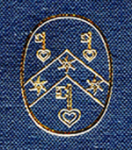 That “coming catalogue” was, and is, of course, the Illustrated Catalogue of Insular, Anglo-Saxon, and Early Anglo-Norman Manuscript Art at Corpus Christi College, Cambridge (see below), in which there appear plates and descriptions to record, to honour, and to represent many forms of marginalia — scribbles, sketches, glosses, revisions, updates, and more. Originally, it was supposed to present “Illustrations” (and “Major Decoration”), because it was intended to complement a publication of similar materials in some other collections (see, for example, here), but, once the publication was agreed, the vaults were opened, and the manuscripts could be inspected directly as possible candidates, the definition of “Manuscript Art” extended to embrace other forms including “lesser” decorated initials, scribbles, sketches, etc. Accordingly, the Catalogue itself — explanatory prefatory texts (of more than 100 pages) apart — has the title: “Catalogue of Manuscripts and Fragments at Corpus Christi College, Cambridge, with Insular, Anglo-Saxon, and Early Anglo-Norman Illustrations, Decoration, and Artists’ Sketches”
That “coming catalogue” was, and is, of course, the Illustrated Catalogue of Insular, Anglo-Saxon, and Early Anglo-Norman Manuscript Art at Corpus Christi College, Cambridge (see below), in which there appear plates and descriptions to record, to honour, and to represent many forms of marginalia — scribbles, sketches, glosses, revisions, updates, and more. Originally, it was supposed to present “Illustrations” (and “Major Decoration”), because it was intended to complement a publication of similar materials in some other collections (see, for example, here), but, once the publication was agreed, the vaults were opened, and the manuscripts could be inspected directly as possible candidates, the definition of “Manuscript Art” extended to embrace other forms including “lesser” decorated initials, scribbles, sketches, etc. Accordingly, the Catalogue itself — explanatory prefatory texts (of more than 100 pages) apart — has the title: “Catalogue of Manuscripts and Fragments at Corpus Christi College, Cambridge, with Insular, Anglo-Saxon, and Early Anglo-Norman Illustrations, Decoration, and Artists’ Sketches”
That expanded approach made it possible also, by design, to include some manuscripts which do not, by most connoisseurs’ assessments, possess “art” with a Capital (or Upper-Class) “A”. “Manuscript Art”, however, may be a different — or also a different — matter, and a wider-, fuller-embracing one.
Then & Now
Looking over that declaration of June 1994 now, I wonder only for an instant if there is anything that I would wish now to change. The subsequent years of research on manuscripts and other forms of written materials from diverse periods and regions allows me to say that, Yes, and mainly or briefly One Thing. And that is to add the plea for looking earnestly at the marginalia also in printed books.
And in that extension of the quest, there is excellent company as well as inspiration. To put it succinctly, and to quote a Master of Marginalia (who has spoken at our 2014 Symposium), Anthony Grafton: “Marginalia is On The March”.
The Genres
A few glimpses of the sorts of pages under consideration at our 1994 Seminar, in this case through Joyce Hill’s detailed comparisons of the different forms of transmission through layout embodied by the surviving witnesses to Ælfric’s Colloquy and their manuscript settings.
This copy keeps close company, by virtue of the adjacent position upon the pages themselves, with one of the 3 surviving 11th-century copies of the Excerptiones de Prisciano. That text comprises a compilation of grammatical excerpts from earlier authorities, including Priscian (active circa 500 CE) himself.
The other copies of the Colloquy occur in 1) a manuscript now at Saint John’s College, Oxford (MS 154); and 2) within the miscellany of Latin and Old English texts in a manuscript which one of the Seminars in our Series had considered, in person, the year before at the British Library: “Cotton MS Tiberius A III” (9 August 1993). In those 2 volumes, the Colloquy stands in the form of main text, with some differences in layout (for example, in 22 lines per page in the former and 23 lines in the latter) as well as in wording.
In the 3rd witness, the copy itself takes the form of marginalia.
The witness to the Colloquy preserved in the manuscript now divided between the Plantin–Moretus Museum (here “P”) in Antwerp and the British Library in London (“L”) presents the Old English Colloquy — in an incomplete version — crammed into the margins on folios P 18r–19v + L 16v–17r. Before the dismemberment and redistribution of the manuscript, its text was continuous.
By occupying and laying claim to the margins, on each page the Old English text forms an angular C-shaped claw or hook pinning in the main text, whose grammatical subject pertains to a schoolbook. Thus does the Colloquy appear on this opening in the London portion (see images below), with those asymmetrically paired, or mirrored, hooks clamping onto the facing pages for dear life, as if, in the haste or determination to make the flight into the next centuries, this marginal text was prepared to accept the conditions and uncertainties, not to mention the discomfort, of Space Available. Whatever Available. Hey, whatever works?
Since it has made that flight, despite or because of the cramped quarters for its time-travel (Bigger On the Inside?), by Hook and By Book, we could marvel about its luck: “Better Late Than Never”.
*****
Not Forgetting the Sketches and Manicula’s
Elsewhere in the same volume, we may see the principles in action whereby those who do not refrain from entering marginalia of whatever kind in books (which they themselves might, or might not, own) might extend their hand also to trying out doodles or sketches, or lend a hand — in the form of a hand, or manicula (“little hand”, plural maniculae), pointing to something worth noticing. That long-standing (or -pointing) tradition extends its hands or fingers also into printed works with the manicle. Handy! (Heh, Heh.)
*****
*****
The Illustrated Catalogue
Most of the manuscripts directly on view at the Seminar appear in the Illustrated Catalogue of Insular, Anglo-Saxon, and Early Anglo-Norman Manuscript Art at Corpus Christi College, Cambridge (1997).
Their assigned places comprise, in that same order,
- Budny Numbers 24, 32, 25, 7, 28, 4, 10, 1, 21, 23 and 44.
More information, plus a Promotional Offer, appears here.
*****
Various seminars or workshops in the Series focused upon one or two of these manuscripts in their own right. For example:
- “Corpus Christi College, Cambridge, MSS 23 and 223”
Parker Library, 5 June 1992 - “Corpus Christi College, Cambridge, MS 41
Parker Library, 11 December 1993
*****
The next Seminar in the Series considered:
- “Manuscript Fragments”
Parker Library, 15 August 1994
That Seminar was the penultimate in the Series before the completion of the 5-year Leverhulme Trust Research Project and the move of the Research Group on Manuscript Evidence to another base. Then emerged other Series of scholarly meetings, described among the Events, Congress Activities, and the Seminars, Workshops, Colloquia & Symposia.
****
As Usual: Unique
As usual, this Seminar was unique. Like the manuscripts.
And like the marginalia, which can also, in the right place, turn an individual copy of a printed text into a unique witness to a particular process at a given time, or set of processes across time. Time-travel in a capsule. To be taken as indicated [Manicula Here], as required or desired.
With their varied food for thought, both this one and the other unique seminars and workshops in the Series on “The Evidence of Manuscripts” formed a nutritious, and in some ways, satisfying, diet. That they might continue to do so resides to some extent in the power of the airways nowadays, with these retrospective reports, or exhibition of sorts, on the official website of the Research Group on Manuscript Evidence.
You are Here, and Hello. More of our activities and events are displayed on other pages and in other posts on this site, for example, here and here. You might also enjoy our blog on — naturally — Manuscript Studies. (With a Contents List, and not only on Manuscripts as such.) Please share your Comments and let us know your interests.
*****

